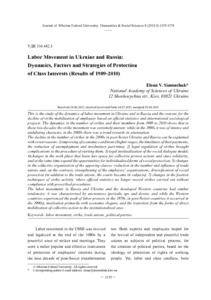Labor Movement in Ukraine and Russia: Dynamics, Factors and Strategies of Protection of Class Interests (Results of 1989-2010)
Скачать файл:
URI (для ссылок/цитирований):
https://elib.sfu-kras.ru/handle/2311/9920Автор:
Simonchuk, Elena V.
Симончук, Е.В.
Дата:
2013-08Аннотация:
This is the study of the dynamics of labor movement in Ukraine and in Russia and the reasons for the
decline of strike mobilization of employees based on official statistics and international sociological
projects. The dynamics in the number of strikes and their members from 1989 to 2010 shows that in
these two decades the strike movement was extremely uneven: while in the 1990s it was of intense and
undulating character, in the 2000s there was a trend towards its attenuation.
The decline in the number of strikes in the 2000s in post-Soviet Ukraine and Russia can be explained
with seven reasons: 1) improving of economic conditions (higher wages, the timeliness of their payments,
the reduction of unemployment and involuntary part-time); 2) legal regulation of strikes brought
complications to the procedure of starting them; 3) legal institualization of the social dialogue model;
4)changes in the work place that leave less space for collective protest actions and class solidarity,
and at the same time expand the opportunities for individualized forms of social protection; 5) changes
in the collective organization of the opposing classes–reduction in the number and influence of trade
unions and, on the contrary, strengthening of the employers’ organizations; diversification of social
protection (in addition to the trade unions, the courts became its subjects); 7) changes in the fixation
techniques of strike activity, where official statistics no longer record strikes carried out without
compliance with prescribed procedures.
The labor movements in Russia and Ukraine and the developed Western countries had similar
tendencies: it was characterized by unevenness (periodic ups and downs; and while the Western
countries experienced the peak of labor protests in the 1970s, in post-Soviet countries it occurred in
the 1990s); motivation primarily with economic slogans; and the transition from the forms of direct
mobilization of collective action to the institutionalized ones. Изучение динамики рабочего движения в Украине и России и причин снижения забастовочной
мобилизации наемных работников предпринято на основании данных официальной
статистики и международных социологических проектов. Динамика количества забастовок
и их участников с 1989 по 2010 год свидетельствует, что в течение двух десятилетий
забастовочное движение было крайне неравномерным: если в 1990-е оно носило интенсивный
и волнообразный характер, то в 2000-е наблюдался тренд к его затуханию.
При объяснении снижения числа забастовок в 2000-е годы в постсоветских Украине и России
выявлено семь причин: 1) улучшение экономической конъюнктуры (повышение заработной
платы, урегулирование своевременности ее выплаты, снижение уровня безработицы и
вынужденной неполной занятости); 2) законодательное урегулирование правил проведения
забастовок, приведшее к усложнению процедуры ее начала; 3) институционализация
модели социального партнерства; 4) изменения в сфере труда, детерминирующие сужение
пространства для коллективных протестных действий и классовой солидарности и
одновременно расширение зоны индивидуализированных форм социальной защиты;
5) перемены в коллективной организации противостоящих классов – снижение
численности и влияния профсоюзов и, напротив, усиление организаций работодателей;
6) диверсификация социальной защиты (ее субъектами, помимо профсоюзов, стали суды,
органы государственного контроля, система индивидуальных договоров); 7) изменение
методики фиксации забастовочной активности, где официальной статистикой теперь не
учитываются забастовки, проводимые без соблюдения прописанных процедур.
Рабочее движение в России и Украине и развитых западных странах имело подобные
тенденции: оно характеризовалось неравномерностью (периодические подъемы и
спады; причем, пик трудовых протестов, который западные страны прошли в 1970-
е годы, в постсоветских пришелся на 1990-е), мотивированностью преимущественно
экономическими лозунгами, переходом от форм прямой мобилизации коллективных действий
к институционализированным.

